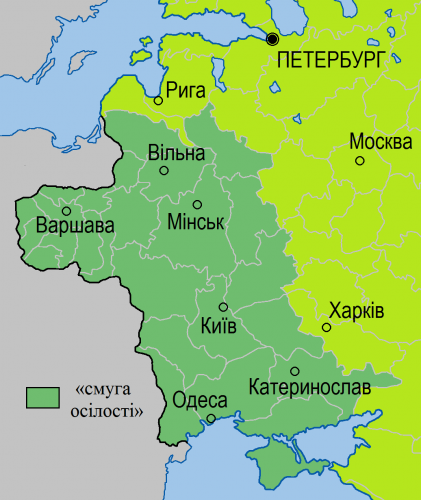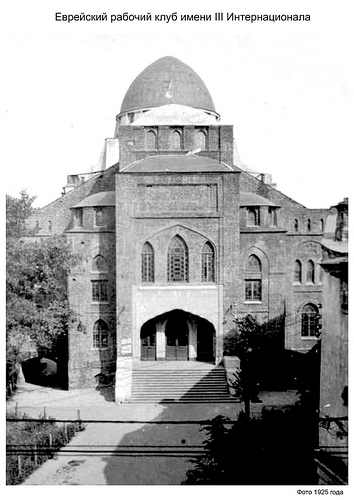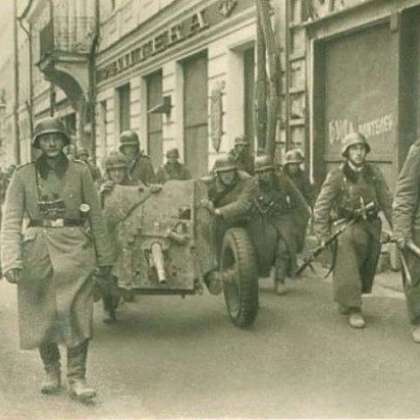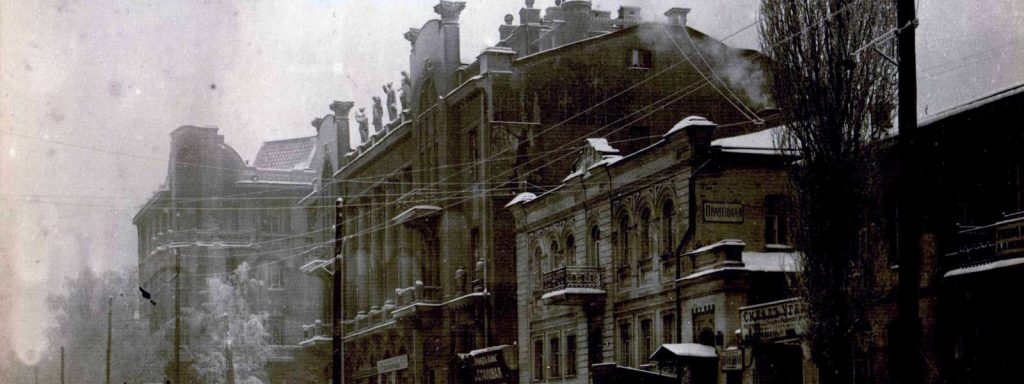Kharkiv: a Jewish island in a non-Jewish sea
Today on the program Encounters the historian Artem Kharchenko talks about Jewish life in nineteenth-century Kharkiv, the Pale of Settlement, and the “Holocaust by Bullets.”
Kharkiv is one of a handful of Ukrainian gubernial cities, where not a single pogrom took place during the tsarist era. The city is also known as the center of Zionism and antisemitism. Kharkiv was not part of the Pale of Settlement, yet it was home to a powerful Jewish community. The historian Artem Kharchenko explores these paradoxes and Jewish life in Kharkiv.
Andriy Kobalia: If the Pale of Settlement was a territory outside of which Jews were not permitted to live, and the Kharkiv region was not included in the Pale of Settlement, then who were the Jews who were living there? Did they have special privileges?
Artem Kharchenko: Among the so-called “Ukrainian gubernias” of the Russian Empire, Kharkiv gubernia was in fact the only one that was not included in the Pale of Settlement. This territory was formed gradually. In popular literature its formation relates to the decisions of Catherine II. The year 1804 is a certain dividing line, when a “romantic idea” emerged in the imperial center: to protect its peasants from Jews, who were trading and creating excessive competition, and exploiting them financially. Their actions were supposed to encourage Jews to move to cities. Another dividing line is 1835, when the “Pale of Settlement” is created and which would exist until 1917.
Who are those Jews arriving in Kharkiv? First of all, they are traders, who came here not to settle down permanently, but were here on business. They comprised part of the first community. This community was not a permanent one. If the authorities had been asked, they would have denied their existence. However, we see them. They appear on lists of residents. We know about the so-called head of the community, the merchant and rabbi Moisei Aleksandrovich. Incidentally, his descendant lives in the United States and is researching his family history.
The second part of this community was comprised of soldiers. It is no secret that the imperial authorities used the army as a tool for integrating the Jewish population into imperial society. There is a wonderful book by [Yohanan] Petrovsky-Shtern about Jews in the Russian army. This situation was also typical of other countries—France, for example. Thus, Jewish soldiers often ended up in Kharkiv. Until 1859 the community was composed of merchants and soldiers.

Andriy Kobalia: I know that a third category existed here: students. Jews with higher education had the right to reside outside the Pale of Settlement. Were there Jewish students in Kharkiv? Was it possible to create Jewish educational institutions in Kharkiv?
Artem Kharchenko: The answer to this question depends on the period. I have said that the year 1859 marked the beginning of a new period. This was a period when the government switched to the policy of “assimilating” and integrating the Jews. The historian Benjamin Nathans has written about the theory of selective integration, when the tsarist government selected social strata that were useful from its standpoint, and settled them outside the Pale of Settlement. The first to be affected by these decisions were merchants, who obtained this right in 1859. Year after year new strata appear that acquire this right, including students as well as jurists, artists, and craftsmen from the “useful professions.”
According to one theory, there were Jewish students here as early as 1814, but their numbers quickly rise in the 1870s. As a rule, these students opted to study medicine and law. Similar decisions were motivated by the fact that these professions allowed for gaining a foothold and remaining outside the Pale of Settlement, and not having to return. We are talking about hundreds of people during various periods of Kharkiv’s history.
Andriy Kobalia: Kharkiv is one of a handful of cities where no anti-Jewish pogroms took place in the 1880s, 1905, or during the Civil War, whereas the pogroms of 1905 swept through the majority of Ukrainian gubernial cities. They occurred in Katerynoslav, Odesa, Mariupol, Kyiv, and other cities. Why were there no pogroms in Kharkiv?
Artem Kharchenko: This is an extraordinary complex question. There is a theory advanced by the Swiss historian Alexis Hofmeister, who has typologized Ukrainian cities. He describes Kyiv as an administrative city, where the economy was secondary; where there existed a heterogeneous middle class that included Jews who were accustomed to negotiating. Odesa was a large trading city, where economic interests were a priority. In juxtaposition to these two cities, he cites the example of Katerynoslav, an industrial city where people were constantly arriving. Kharkiv is somewhere between Kyiv and Odesa.
When this tradition is missing, the first generation falls under the harsh conditions of industrialization, and its life is difficult. The wave of pogroms that took place in 1881–1882 was often linked to the initiative of the imperial government. Today these events are linked to the lower classes’ dissatisfaction with what they perceived as the wealth and omnipotence of the Jews. By means of a pogrom, they sought to overcome injustice. It was not necessary to kill. During this wave around fifty people were killed. The year 1905 is another story. The government was partly responsible for this wave. In Kharkiv people knew how to negotiate, despite the potent antisemitism in the city.
Andriy Kobalia: Incidentally, with regard to antisemitism, we know that Kharkiv was one of its centers, where the Black Hundreds movement developed. On the other hand, Kharkiv was also a center of Zionism, the Jewish national movement. How could these two phenomena coexist within the same city?
Artem Kharchenko: The period of the 1870s was the dividing line between two phenomena in the city: traditional Judaeophobia and antisemitism, which was just emerging. The former is unfriendliness toward Jews and the accusation that they were implicated in the death of Christ. A Jew could accept baptism. During the wave of pogroms in 1881–1882 Jews were forced to accept Christianity. The emergence of the Black Hundreds movement and antisemitism, which were based on racist European theories, did not offer any chances for “correction” via baptism.
There were episodes when the central government issued clear-cut signals that Jews should not live in Kharkiv. However, there was constant conflict among the various branches of government on various levels. The middle level—the gubernial government—often concealed the problem. There were cases of Judaeophobic denunciations on the part of local residents. For example, one Bystrovsky complained that he had seen Jews selling holy icons. He did not like this, and here we see the religious aspect. However, I would not exaggerate the degree of antisemitism.
During the nineteenth century Jews went from being a religious community to a nation. Many of its representatives associated themselves with this territory, and not everyone wanted to leave. The Zionist movement is born here. I am talking about the BILU group that was initiated by students. It took its name from [the Hebrew initials of the biblical verse] “House of Jacob, let us go up”). The members of this group declared that people had to go to the holy land, to Erets Yisra’el. This history began in Kharkiv, and later the group moved to Odesa.
In this context, Kharkiv is known for a conference that was held here, which criticized the father of Zionism, Theodor Herzl, in connection with his study of Great Britain’s “Uganda Scheme.” Herzl ended up having to publish a response in the Vienna newspaper Die Welt, in which he accused the conference participants of violating discipline.

Andriy Kobalia: The synagogue is frequently the center of a Jewish community. Self-organization and charitable works take place around this center. We have already talked about Jewish life in Kyiv, Odesa, Katerynoslav (Dnipro), Lviv, and Chernivtsi. Which buildings represent Jewish architecture in Kharkiv, and what remains of it today?
Artem Kharchenko: On the eve of the Revolution of 1917 there were twenty-five prayer houses and synagogues. Later, they were all closed “at the request of the Jewish proletariat.” The Choral Synagogue, on Pushkin Street, is very famous. But this is a rather late synagogue that was established during the fall of the empire. It represented emancipated circles, people who had already acclimatized to the Kharkiv community. This is a huge synagogue with about a thousand seats. According to one story, the plans were commissioned outside of Kharkiv. People turned to St. Petersburg and held a competition in 1909–1910. It was completed in 1913. The synagogue was built in the Moorish style because its architects believed that the roots of Judaism lie in the East, and Eastern elements should therefore be part of the architectural design.
Our city also has a lot of buildings that were once prayer houses; for example, Mishchanska Synagogue in the vicinity of the Kharkiv promenade. This building is connected with the grim events of the Holocaust. There are other buildings that are not performing their functions at the present time. For example, our planetarium is also a former synagogue.
Andriy Kobalia: We were talking about pre-Soviet Kharkiv. What changed in Jewish life after the consolidation of Bolshevik rule?

Artem Kharchenko: In the 1920s it seemed as though everything would be fine. The government gave the impression that it was offering the possibility of full emancipation. In his book, The Affirmative Action Empire, the historian Terry Martin writes that the Soviet government went very far with its national experiments. The Jewish community obtained the same rights for implementation. It was a veritable cultural explosion, with Jewish artists, writers, poets, theatre life. However, religious life utterly disappeared.
In 1918 Aran Zalman described Kharkiv as a city of the future. For example, there were plans to turn the KhTZ raion [the Kharkiv Tractor Factory district—Ed.] into a city of the future. Zalman wrote about Kharkiv as a city where Ukrainians and Jews would live together. It is interesting he did not mention Russians. He wrote about a Jewish-Ukrainian city with a Shevchenko Street and a Sholem Aleichem Street. However, during the harsh 1930s a lot of things fell to pieces. The repressions also affected the Jews.

Andriy Kobalia: The rich Jewish life in Ukraine came to an end with the arrival of the Nazis. What is Kharkiv’s experience with them? How did the “Holocaust by Bullets” take place here?
Artem Kharchenko: Traditional Jewish life was brutally cut short by the war. In June 1941 Kharkiv was quite far from the front. Thus, when the Nazis arrived here in October of that year, most Jews had already left the city. As for those who remained, their fate was typical, unfortunately. On a frosty day more than ten thousand Jews were assembled and led down Moskovsky Prospekt, a distance of eleven kilometers. When they reached the barracks situated between today’s metro stations KhTZ [Kharkiv Tractor Factory—Ed.] and Industrialna, their lives ended in Drobytsky Yar. These were mostly women, children, and elderly people. However, I would not say that Kharkiv’s Jewish life came to an end. After the war many Jews returned. Kharkiv remains one of the largest centers of Jewish life today.
This program was made possible by the Canadian non-profit organization Ukrainian Jewish Encounter.
Originally appeared in Ukrainian (Hromadske Radio podcast) here.
NOTE: The UJE does not necessarily endorse opinions expressed in articles and other materials published on its website and social media pages. Such materials are posted to promote discussion related to Ukrainian-Jewish interactions and relations. The website and social media pages will be places of information that reflect varied viewpoints.




















